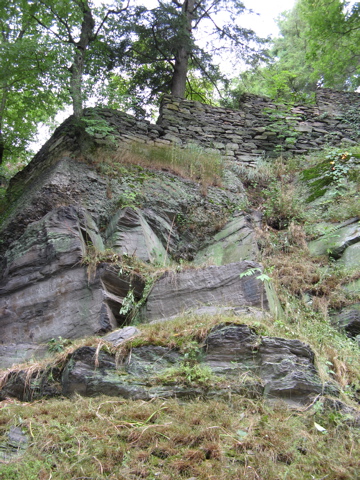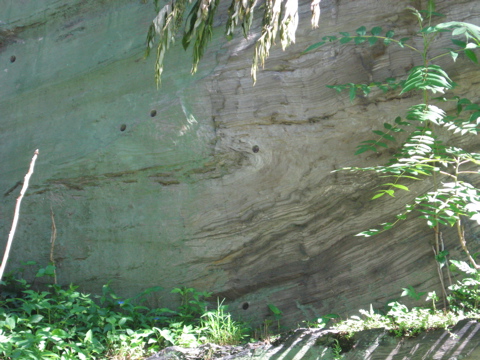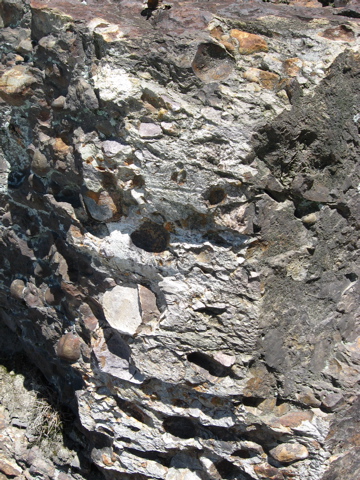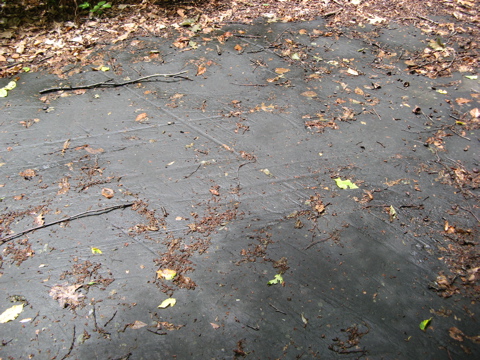Teacher Notes in Yellow
This region features rock types of the "Roxbury Formation": Conglomerate, Sandstone and Mudstone. The lesson here is to get students to think about the different conditions that would lead to the formation of these three different sedimentary rocks. Understand that there is still consirable uncertainty among geologists about the exact conditions of the formation of these rocks. However, the general environments under which they formed is clear. Students can use this "field trip" to develop a general sense of how sedimentary rocks form.
The Conglomerate must have formed under conditions of rapid weathering and erosion - most likely fast moving, powerful streams or rivers carrying rocks and boulders quickly to the bottom of a mountain. These sediments would have been deposited in a very shallow waterway, because only finer-grained sediments could have been carried out to deeper waters. The finer-grained sandstones and mudstones must have formed in deeper water, or under more gentle erosional conditions.
A puzzle for students to consider: how is it possible for the same location to feature such different sedimentary conditions? Was this the result of changing sea level? Periods of uplift? Periods of intense mountain building (such as volcanism or converging plate boundaries) followed by periods of relative calm? Note that there is no right answer here, but challenging students to consider their evidence when forming their hypothesis is an important exercise.
The two pictures below show layers of Roxbury Conglomerate and Sandstone (and possibly some mudstone as well). Can you spot where the different rock types are in these pictures? Don't let the rock wall on top confuse you!


Look carefully at the next 5 pictures.
What kinds of conditions do you think the different rock types formed in? Draw or describe the places where the sediments were deposited that eventually cemented together to form rock.
The sediments that formed these rocks were all deposited in the same location, but at different times. What do these rocks tell you about changes in the environment, in this location, over time?





Notice that much of the sandstone you see in the three pictures below has ripples and waves in it. What processes would cause this to occur?
Most of the waviness observed in rock layers shown in these pictures are probably evidence of deformation of the sediments (before they solidified into rock), such as what would happen when a section of sand or mud slides down a slope. Evidence for this is that there are undeformed layers above and below the deformed layers; if the folding occured after the rock was formed you would see the same deformation occuring all the way through.



Matching Game!
Try to match the rock with the description of how it was formed.
A. Pebbles, boulders, sand and mud are scraped up by the movement of glaciers. This "glacial till" gets deposited at the bottom of a shallow waterway. Over time the rocks and sand get cemented together to form rock.
B. Pebbles and small boulders are deposited, along with sand, at the bottom of a shallow waterway. Over time the rocks and sand get cemented together to form rock.
C. Sand is deposited at the bottom of a deep waterway. Over time the rocks and sand get cemented together to form rock.



Need the answers? Click here
Hidden in the woods, behind Bloomingdale's at the Chestnut Hill Mall (near the bus stop), is a flat outcropping of rock. This rock happens to be Roxbury Conglomerate, although it has been so smoothed out that it's hard to see the rock type in the pictures. (The second picture is a zoomed-in copy of the first.)
You'll notice that the surface has two sets of scratches almost perpendicular to each other. One of these sets of scratches was caused by the glaciers as they advanced South. (We call this "glacial scarring".) The other set of scratches was caused by heavy equipment during the construction of the shopping mall.
Can you tell which set of scratches is which? And, can you tell which direction is North?


If you look closely, you'll notice that the horizontal scratches are cut over the more vertical scratches. This indicates that they formed more recently. In addition, you can use the shadows to help you determine that North is roughly "up" on these pictures. Thus, the more vertical scratches came from the receding glaciers.